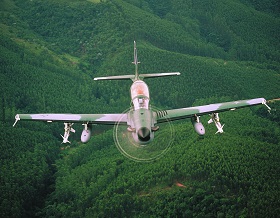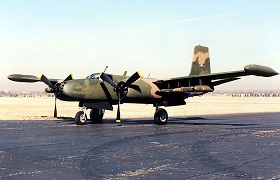It is beyond a shadow of a doubt that dominance in the skies is now half the battle, as aviation power can both turn a war around, even if the enemy prevails on the ground as in Libya, and to defeat an opponent without any ground operation, or what we saw during the 1999 NATO mission in Yugoslavia. But supersonic jets operating thousands of miles from their bases and delivering surgical strikes with tons of bombs and missiles have a major shortcoming. They are expensive, hideously expensive.
A Costly Pleasure
During the Second World War, the average aircraft was priced on par with a tank [1]. Only later did aviation become the boon of the technology revolution, making price climbs a swift and nonstop affair. For example, in the fiscal year 1998, the M1A2 Abrams tank cost roughly USD 6 million [2], while the cost of an F-16C fighter reached USD 27 million [3]. Of note, Abrams is one of the most expensive tanks in the world, while the F-16C Fighting Falcon is comparatively cheap for Western defense sectors, with the heavy twin-engine, multipurpose fighter F-15E Strike Eagle going for around USD 55 million [4]. This difference in price is far from dramatic, as the market price of the Russian T-90 tank runs at USD 3 million [5] (with Chinese-made and upgraded second-hand tanks even cheaper), whereas up-to-date fighters like the European Typhoon and Rafale exceed USD 100 million per unit [6]. At the same time, the purchasing price of an aircraft is augmented by substantial maintenance costs – one flight hour of a modern aircraft costs a lot as well. The Typhoon requires USD 8,200 worth of fuel per hour, with the total price for one flight hour assessed by Jane's at USD 18,000 [7]. Bearing in mind that the annual aircraft flight time exceeds 200 hours (more than 100 hours per pilot, with more pilots than aircraft) and adding in the cost of spare parts, periodic overhauls, precision weapons and extensive training, aviation is definitely a toy for the rich.
But this toy is not something a country can live without. While the rich enjoy the fruits of advanced technology, the poor are working hard to find a solution.
Buying Second Hand
During the Cold War, third-world countries were able to acquire aircraft more easily, since both the Soviet Union and the United States often provided their less affluent allies with weapons either free of charge or through preferential credit programs. The Americans even developed the popular F-5, aka Free World Fighter, because during this time, U.S.-made aircraft turned out to be too sophisticated for its junior partners. The USSR and Europe, primarily France, sufficed with the development of more simplified, export-oriented versions. Today, only close U.S. allies can expect free gifts, and only on a much lesser scale than before, while third-world countries cannot imagine someone supplying them with free aircraft to fight against rebels or similarly poor neighbors in exchange for public commitments about membership in a certain international camp. In addition, developing countries cannot afford to operate the latest aircraft, even if they find the cash to buy one.
A textbook example comes from South Africa, quite prosperous by African standards, which purchased Swedish JAS-39 Gripen fighters but is running badly short of money for their operation [8]. And the Gripen is one of cheapest fourth-generation fighters.
Second-hand aircraft offer an obvious option that works along two major dimensions.
The first is the sale of aircraft from the former USSR, coming mainly from Russia and Ukraine, with Kiev boasting the second largest European air force in 1992 [9]. In the 1990s, the key buyers were poor African states keen on MiG-29s, Su-25s and Su-27s, all of them quite sufficient physically and operationally in those days. A good example is what happened during the Ethiopia-Eritrea conflict in 1998-2000, when Russia supplied aircraft to both sides [10]. Eritrea also closely cooperated with Ukraine. Although no official data exist, Ethiopian aircraft may have been manned by Russian and Eritrean pilots – by Ukrainian "specialists" [11].
In the early 2000s, Russia began to lose interest in the sale of used aircraft, because the revival of its aircraft construction sector and huge orders from India and China helped compel Moscow to export new aircraft. Moreover, the Russian Air Force was running out of extra planes – those still operable had been repaired and upgraded for domestic purposes as a temporary measure until the new models were built. Ukraine has continued the second-hand sales whenever an opportunity turned up, having sold over one hundred MiG-24s as well as other units bought in order to be dismantled for spare parts [12]. Ukraine continues to sell its combat aircraft despite domestic tensions; last June a repaired and freshly painted MiG-29UB, ready for delivery to Sudan, was witnessed at the Lvov State Aircraft Repairs Plant [13].
The second conduit for reselling used combat aircraft lies in the West. Americans usually trade in aircraft housed at desert cemeteries, while Europeans focus on trading aircraft taken straight from their air forces, which continue to contract in size since the end of the Cold War. U.S. and European sales policies are strictly selective, as they sell aircraft only to poor or loyal allies, for example with sales to Portugal or the delivery 12 F-16s to Romania in 2015 [14]. The United States has also provided Indonesia with 24 upgraded F-16s beginning this summer [15].
However, used fighters cannot meet the numerous states’ demand for cheap aircraft suitable for low intensity conflicts. First of all, this type of aircraft is costly to operate, have too many (unnecessary) capabilities, and in some cases absolutely are unfit for attacks on irregular armies. Mach 2 aircraft are not suitable for searching rebel camps in the jungle and powerful electronic warfare systems are useless against a jeep caravan in the desert. Low-cost flight hours, simple operation and training, and rough runway capabilities instead are just what the doctor ordered.
A Good Bargain
Militaries have long understood that in counterinsurgency warfare, seemingly archaic planes can easily beat state-of-the-art aircraft. Propeller aviation's swansong came in Vietnam. This was the first major war of the new era known for the extensive use of supersonic jets equipped with high-power radar, air-to-air and air-to-surface missiles and guided bombs, and supported by tankers and AWACS platforms. However, the Americans did not shy away from their WWII-era machines, for example the A-1 Skyraider and A-26 Invader attack aircraft. It was the Vietnam War that encouraged designers to create a multitude of seemingly freakish light attack aircraft. We need only to be reminded of attempts to mass-produce the legendary WWII fighter Mustang which had been extensively upgraded for combat missions [16].
Today's renaissance of propeller aviation rests on training and farming planes, the most popular being the Super Tucano made by Brazil's Embraer, Swiss Pilatus airplanes, and the American Beechcraft T-6 Texan II, all modeled on this approach. The world leader in converting agriculture airplanes into counterinsurgency fighters is American IOMAX with its Archangel family that offers cockpit equipment, sensors, and weapons systems fit for integration into different air platforms.
New models are also emerging, among them the original pusher-airscrew AHRLAC reconnaissance and counterinsurgency aircraft [17]. The most advanced model appears to be the Scorpion by Textron, which normally uses the Bell brands, Cessna and its other holdings. This is a jet mostly assembled of civilian components and meant to fill the niche between propeller and full-fledged combat aircraft [18]. The U.S. National Guard appears to be cautiously interested.
While differing in appearance, these aircraft share certain features:
- Up-to-date targeting and navigation equipment on par with regular combat airplanes.
- The use of precision weapons, including guided bombs and light missiles.
- The absence of heavy armor due to weight limitations, as it is believed that if the enemy has efficient antiaircraft artillery, the two above mentioned features will help plane to climb to medium-level heights and then employ precision weapons.
- A focus on lowering costs both for the aircraft and flight hours.
- Missions, including reconnaissance, border control, humanitarian operations in emergencies, and attacks on poorly armed irregular groups.
Iraq, a country ablaze, offers an interesting example for a low-cost air force that includes reconnaissance Combat Caravans fighters converted from light passenger planes, along with hastily purchased used Su-25s from Russia, with more Su-25s expected to arrive. At the same time, Washington keeps delaying the delivery of modern F-16s, fearing that they will get into the wrong hands.
Is there an opening for Russia in this promising market? Many of Moscow's permanent clients are not wealthy, but Russia regrettably has no program for building a low-cost combat aircraft equipped with advanced avionics and weaponry. The reason might lie in the fact that in other countries, this niche is occupied by comparatively small private firms, while the Russian United Aircraft Building Corporation focuses on domestic programs. At the same time, there appears to be a silver lining due to the rearmament process launched by the Russian Air Force which should result in many used aircraft becoming available. Overhauled and upgraded in the early 2000s, the Su-24, Su-25s and Su-27s should sell well in the third world even until the early 2020s. African and poor Asian states badly need to replace their obsolete Soviet-made aircraft and their Chinese clones, while neglecting these apparently cheap deals is obviously not in their interest for these aircraft often provide the basis for larger-scale military-technical cooperation.
1. In 1941, the manufacturing cost of Yak-1 was about 158,000 rubles., while the T-34 ran at 269,000 rubles. The proportional difference in price remained, despite the cheaper and simpler production of both – in 1943, T-34 cost 135,000 rubles and the fighter was 115,000 rubles.
2. http://www.globalsecurity.org/military/library/budget/fy1998/dot-e/army/98m1a2.html
3. http://www.globalsecurity.org/military/systems/aircraft/f-16-specs.htm
4. http://www.globalsecurity.org/military/systems/aircraft/f-15-specs.htm
5. http://www.army-guide.com/eng/product889.html
6. http://periscope2.ru/2014/04/25/8134/; http://bmpd.livejournal.com/837678.html
7. http://www.stratpost.com/wp-content/plugins/post2pdf-converter/post2pdf-converter-pdf-maker.php?id=6342
8. http://periscope2.ru/2013/03/13/7143/
9. http://defendingrussia.ru/iron/chem_voyuyut_na_ukraine_aviatsija_mnenie
10. http://www.airwar.ru/history/locwar/africa/eritrea/eritrea.html
11. Sukhoi vs. MiG. Wings of Russia magazine. Issue 1, 2010. http://www.vokrugsveta.ru/tv/vs/stories/ethiopia/8/
12. Arms Export magazine, Issue 5, 2013
13. http://bmpd.livejournal.com/906165.html
14. http://www.lockheedmartin.com/us/news/press-releases/2014/may/140513ae_romania-welcomed-to-f-16-family.html
15. http://www.f-16.net/f-16-news-article4877.html
16. http://www.aviastar.org/air/usa/piper_pa-48.php
17. http://www.ahrlac.com/
18. http://nvo.ng.ru/armament/2014-02-07/9_scorpio.html
19. http://www.nationaldefensemagazine.org/archive/2014/August/pages/
TextronAirLandTargetsNationalGuardforPotentialSales.aspx
20. http://bmpd.livejournal.com/903326.html
21. http://tvzvezda.ru/news/forces/content/201407291401-3rq0.htm
22. http://blogs.militarytimes.com/flightlines/2014/07/03/plan-to-deliver-f-16s-to-iraq-on-hold/






